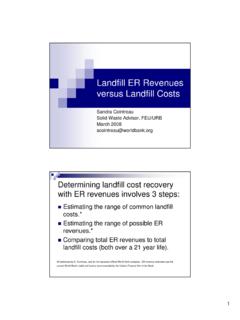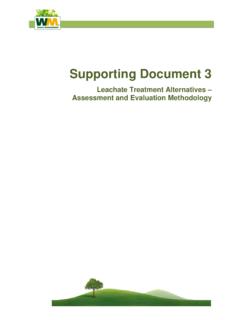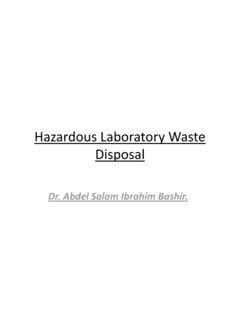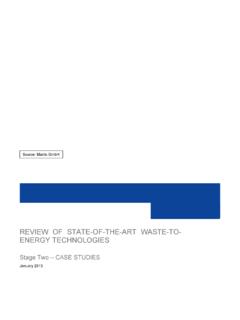Transcription of POST-HARVEST FOOD LOSSES ESTIMATION- …
1 1 POST-HARVEST food LOSSES estimation - DEVELOPMENT OF CONSISTENT METHODOLOGY INTRODUCTION Jaspreet Aulakh and Anita Regmi Current world population is expected to reach billion by 2050 (UN March, 2013), further adding to global food security concerns. This increase translates into 33% more human mouths to feed, with the greatest demand growth in the poor communities of the world. According to Alexandratos and Bruinsma (2012), food supplies would need to increase by 60% (estimated at 2005 food production levels) in order to meet the food demand in 2050. food availability and accessibility can be increased by increasing production, improving distribution, and reducing the LOSSES . Thus, reduction of POST-HARVEST food LOSSES is a critical component of ensuring future global food security. food and Agriculture Organization of predicts that about billion tons of food are globally wasted or lost per year (Gustavasson, et al. 2011). Reduction in these LOSSES would increase the amount of food available for human consumption and enhance global food security, a growing concern with rising food prices due to growing consumer demand, increasing demand for biofuel and other industrial uses, and increased weather variability (Mundial, 2008; Trostle, 2010).
2 A reduction in food also improves food security by increasing the real income for all the consumers (World Bank, 2011). In addition, crop production contributes significant proportion of typical incomes in certain regions of the world (70 percent in Sub-Saharan Africa) and reducing food loss can directly increase the real incomes of the producers (World Bank, 2011). Over the past decades, significant focus and resources have been allocated to increase food production. For example, 95% of the research investments during the past 30 years were reported to have focused on increasing productivity and only 5% directed towards reducing LOSSES (Kader 2005; Kader and Roller 2004; WFLO 2010). Increasing agricultural productivity is critical for ensuring global food security, but this may not be sufficient. food production is currently being challenged by limited land, water and increased weather variability due to climate change. To sustainably achieve the goals of food security, food availability needs to be also increased through reductions in the POST-HARVEST process at farm, retail and consumer levels.
3 food LOSSES do not merely reduce food available for human consumption but also cause negative externalities to society through costs of waste management, greenhouse gas production, and loss of scarce resources used in their production. food loss is estimated to be equivalent to 6-10 percent of human-generated greenhouse gas emissions (Gustavasson, et al. 2011; Vermeulen, et al. 2012). A significant contributor of this problem is through methane gas generation in landfills where food waste decomposes anaerobically (Buzby and Hyman, 2012). The US Environmental Protection Agency reports that in the United States about 31 million MT of food 2 waste accounted for 14% of the 2008 solid waste produced in the country (EPA, 2011) costs roughly billion dollars to landfill (Schwab, 2010; Buzby and Hyman, 2012). This is cost to the society through utilities bills and taxes. A study by Institute of Mechanical Engineers indicates that that current agricultural practices use Gha (global hectares or 4931 million hectares) of the total Gha (14894 million hectares) of land surface on the earth (Fox and Fimeche, 2013).
4 Agricultural production in addition uses trillion m3 of water per year and over 3% of the total global energy consumption (Fox and Fimeche, 2013). With estimated food LOSSES of about 30-50 % of total production, this translates to wasting Gha of arable land, trillion m3 of water and 1% to of global energy (Fox and Fimeche, 2013). Given the significant role food loss reductions could have toward sustainably contributing to global food security, it is important to have reliable measures of these LOSSES . Unfortunately, most of the available postharvest loss and food waste estimates are based on the anecdotal stories with few actual measured or estimated numbers. Moreover these numbers, in turn, feed into estimates of food availability which are widely used in food security assessments and policy analyses. For example, FAO s food Balance Sheet provides data for most food security and consumption analyses across the world ( ) and presents a comprehensive picture of a country's food supply during a specified reference period.
5 food supply available for human consumption is obtained by deducting from total supplies the quantities exported, fed to livestock, used for seed, and LOSSES during storage and transportation. The food loss estimate in the Balance Sheet is currently calculated using an ad hoc methodology. A robust accounting of food LOSSES which is updated regularly will improve the overall data in the food Balance Sheet and provide more reliable information for analyses and policy making. In light of this need, this paper illustrates a conceptual model which will support the development of a template for estimating the POST-HARVEST LOSSES in different staple crops. This paper is divided into four main sections- the first section defines food loss and food waste, the second section discusses the factors responsible for the current food loss situation in different parts of world, and the third section talks about measurement problems, and existing methodologies. The final section of this paper proposes a conceptual model that aims at strengthening future PHL estimates.
6 food LOSSES AND food WASTE POST-HARVEST food Loss (PHL) is defined as measurable qualitative and quantitative food loss along the supply chain, starting at the time of harvest till its consumption or other end uses (De Lucia and Assennato,1994; Hodges, Buzby and Bennett, 2011). PHLs can occur either due to food waste or due to inadvertent LOSSES along the way. Thus, food waste is the loss of edible food due to human action or inaction such as throwing away wilted produce, not 3 consuming available food before its expiry date, or taking serving sizes beyond s one s ability to consume. food loss on the other hand, is the inadvertent loss in food quantity because of infrastructure and management limitations of a given food value chain. food LOSSES can either be the result of a direct quantitative loss or arise indirectly due to qualitative loss. food loss and food waste add to contribute to POST-HARVEST food LOSSES as presented in Figure 1. food LOSSES can be quantitative as measured by decreased weight or volume, or can be qualitative, such as reduced nutrient value and unwanted changes to taste, color, texture, or cosmetic features of food (Buzby and Hyman, 2012).
7 Quantitative food loss can be defined as reduction in weight of edible grain or food available for human consumption. The quantitative loss is caused by the reduction in weight due to factors such as spillage, consumption by pest and also due to physical changes in temperature, moisture content and chemical changes (FAO, 1980). This definition is unsatisfactory since food grains undergo reduction in weight due to drying, a necessary postharvest process for all grains (FAO, 1980). Although this process involves considerable reduction in weight, there is no loss of food value, and therefore, should not be counted as loss. Therefore our analysis will only consider quantitative LOSSES due to spillage and other unintended LOSSES along the supply chain rather than intentional weight loss through drying or other processing. The qualitative loss can occur due to incidence of insect pest, mites, rodents and birds, or from handling, physical changes or chemical changes in fat, carbohydrates and protein, and by contamination of mycotoxins, pesticide residues, insect fragments, or excreta of rodents and birds and their dead bodies.
8 When this qualitative deterioration makes food unfit for human consumption and is rejected, this contributes to food loss. food waste, as earlier mentioned, is a subset or sub-category of the food LOSSES (Buzby, and Hyman, 2012). According to Buzby and Hyman, Bloom (2010), food waste occurs when the an edible food item goes unutilized as a result of human action or inaction and is often the result of a decision made farm-to-fork by businesses, governments, and farmers (Buzby and Hyman, 2012). The definitions of food waste and food LOSSES are not consistent worldwide. For , Buzby, and Hyman, 2012, report that Dutch Ministry of Economic Affairs, Agriculture, and Innovation defines food waste to include quality considerations and residual and waste flows in addition to the food loss (Waarts et al., 2011). Wastes & Resources Action Programme (WRAP) final report in 2009 defines waste as any substance or object which the holder discards or intends or is required to discard (Quested and Johnson, 2009).
9 Different studies use appropriate definitions for their needs. 4 Fig. 1. POST-HARVEST food loss components. FACTORS CONTRIBUTING TO TOTAL food LOSS Factors that contribute to food loss range from mechanization of practices such as harvesting to handling, processing and others, to weather conditions, production practices, management decisions, transportation facilities, grading issues, infrastructure, consumer preferences/attitudes, and availability of financial markets. A typical POST-HARVEST chain comprises of a number of stages for the movement of harvested output from the field to the final retail market. The LOSSES incurred at each step vary depending upon the organization and technologies used in the food supply chain. For example, in less developed countries where the supply chain is less mechanized, larger LOSSES are incurred during drying, storage, processing and in transportation (Fig. 2). 5 Fig. 2. Traditional versus mechanized postharvest chain (Hodges, Buzby, and Bennett, 2011).
10 The magnitude and pattern of POST-HARVEST LOSSES (PHLs) therefore vary across countries based on their stage of economic development. In high- and middle-income countries, significant LOSSES occur in the early stages of the food supply chains and at the consumer level (United Nations, 2011). Field LOSSES at early stages may reflect economic decision by the farmer to forgo harvesting due to market conditions or grading perfections demanded by the consumers. Minor LOSSES may also occur at other stages of the supply chain. food LOSSES are relatively high across many commodities for the developed countries (Figure 3). This could be a reflection that food wastes at the consumer level tend to predominate food LOSSES in the developed countries. Key factors which are responsible for the food waste in the developed countries are growing consumer intolerance of substandard foods or cosmetic defects such as blemishes and misshapen produce, as well as consumer purchases of more food than they consume.

















